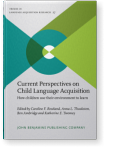Heads, shoulders, knees and toes
What developmental robotics can tell us about language acquisition
Decades of research have brought us a long way in understanding the many factors that affect language acquisition. However, while a wealth of empirical studies have characterised children’s language learning behaviours, from pre-speech to syntax, until relatively recently researchers have been unable to explicitly test developmental mechanisms. However, advances in computational modelling and in particular in developmental robotics have allowed researchers to implement and test developmental theories, specifying explicitly the knowledge and cognitive computations assumed to be at play during language development. The current chapter reviews a series of developmental robotics models of the early stages of language development, illustrating (a) the importance for future theory development of cross-disciplinary collaboration and (b) an emerging new view of language acquisition in which nonlinguistic – as well as linguistic – input drives language development.
Article outline
- Preface
- Introduction
- Why models?
- Why robotics?
- Gaze following and joint attention
- First vocalisations
- First words
- Abstract words
- Syntax
- Conclusion
-
References
